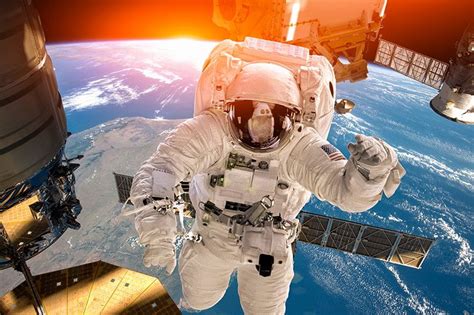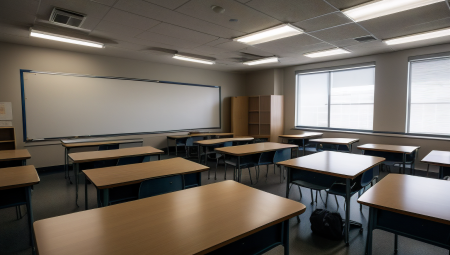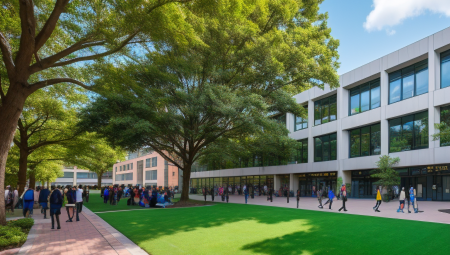Space exploration has always been a captivating subject, and the United States has been at the forefront of space science and technology programs. From the early days of the Apollo missions to the current endeavors in Mars exploration, US universities have played a crucial role in advancing our understanding of the cosmos. In this blog post, we will delve into the world of space science and technology programs at US universities, exploring the various aspects that make these programs so influential. From cutting-edge research areas to hands-on learning opportunities for students, and from partnerships with government agencies and NASA to the impacts of space science and technology research, we will examine the role of US universities in shaping the future of space exploration. Join us as we take a closer look at the leading programs, influential professors, and future innovations in this fascinating field.
Table of Contents
Overview of Space Science and Technology Programs
Space science and technology programs are instrumental in advancing our understanding of the universe and developing innovative technologies for space exploration. These programs encompass a wide range of disciplines, including astrophysics, planetary science, aerospace engineering, and robotics.
One of the key components of space science and technology programs is research and development. Scientists and engineers in these programs conduct cutting-edge research in areas such as space exploration, satellite technology, and space weather. They work on developing new technologies and methodologies for space missions, as well as collecting and analyzing data from satellites and spacecraft.
Another important aspect of space science and technology programs is education and outreach. Universities and research institutions offer hands-on learning opportunities for students through internships, co-op programs, and research projects. These programs provide students with the opportunity to work on real-world space science and technology projects and gain practical experience in the field.
Overall, space science and technology programs play a crucial role in advancing our knowledge of the universe and developing technologies that enable us to explore and understand space. Through research, education, and collaboration, these programs have a lasting impact on space exploration and contribute to the advancement of science and technology.
The Role of US Universities in Space Exploration
US universities play a crucial role in the advancement of space exploration. They serve as hubs for groundbreaking research and innovation in the field of space science and technology. Through their partnerships with government agencies and organizations such as NASA, universities contribute significantly to space missions and projects.
Leading universities in the US have established specialized programs and centers dedicated to space exploration, where students and researchers collaborate on cutting-edge projects. These programs provide hands-on learning opportunities for students, allowing them to gain practical experience in space science and technology.
Interdisciplinary collaboration is a key aspect of the involvement of US universities in space exploration. Researchers from various fields such as astronomy, engineering, physics, and computer science come together to work on solving the complex challenges of space exploration. This collaboration fosters innovative approaches and solutions to push the boundaries of space science.
The influential professors in the field of space exploration at US universities are driving forces behind the success of space science and technology programs. Their expertise and mentorship inspire students to pursue careers in space exploration, further contributing to the growth of the industry.
Cutting-edge Research Areas in Space Science
Since the dawn of human existence, the universe has fascinated and perplexed us. Through the ages, we have made tremendous progress in understanding the cosmos, and today, our exploration of space is more ambitious and innovative than ever before. Space science and technology have opened up a world of possibilities, enabling us to discover new phenomena, develop cutting-edge technologies, and push the boundaries of human knowledge. In this blog post, we will explore some of the most exciting and cutting-edge research areas in space science that are shaping the future of space exploration.
One of the most intriguing areas of research in space science is the study of exoplanets. With the discovery of thousands of planets outside our solar system in recent years, scientists are now able to investigate the potential habitability of these distant worlds. By identifying exoplanets with conditions similar to Earth, researchers hope to find signs of life beyond our planet, revolutionizing our understanding of the universe and our place within it.
Another exciting frontier in space science is the exploration of black holes. These enigmatic cosmic phenomena, with their immense gravitational pull, have long captured the imagination of scientists and the public alike. Recent breakthroughs in our ability to observe and study black holes, such as the first-ever image of a black hole’s event horizon, have provided new insights into the nature of these mysterious objects and their role in shaping the cosmos.
Advancements in space technology have also paved the way for innovative research in the field of astrobiology. By studying extreme environments on Earth, such as deep-sea hydrothermal vents and polar ice caps, scientists are gaining valuable insights into the potential for life in the harsh conditions of other planets and moons in our solar system. This research is not only expanding our knowledge of the conditions necessary for life, but also informing future missions to search for life beyond Earth.
Furthermore, the study of cosmic phenomena such as dark matter and dark energy continues to be a major focus of research in space science. Although these invisible substances make up the vast majority of the universe, their nature remains one of the greatest unsolved mysteries in physics. The quest to unravel the secrets of dark matter and dark energy represents a fundamental challenge that drives scientific innovation and exploration in the field of space science.
Interdisciplinary Collaboration for Space Exploration
Interdisciplinary collaboration is crucial for advancing space exploration. By bringing together experts from various fields such as astronomy, engineering, and biology, innovative solutions can be found to the complex challenges of exploring outer space.
One example of successful interdisciplinary collaboration is the collaboration between astrophysicists and engineers to develop new telescope technology that can capture high-resolution images of distant galaxies. This collaboration has led to groundbreaking discoveries in the field of cosmology.
Another important aspect of interdisciplinary collaboration in space exploration is the collaboration between scientists and psychologists to study the psychological effects of long-term space travel on astronauts. By understanding the mental and emotional well-being of astronauts, space agencies can better prepare for future long-duration missions.
Furthermore, interdisciplinary collaboration is also essential for developing sustainable technologies for space exploration, such as advanced life support systems and propulsion technologies. By working together, scientists, engineers, and researchers from different fields can address the complex and multifaceted challenges of space exploration.
Hands-on Learning Opportunities for Students
Hands-on learning opportunities for students in the field of space science and technology are crucial for their overall understanding and skill development. This hands-on approach allows students to apply theoretical knowledge to practical experiments and projects, thereby enhancing their problem-solving and critical thinking abilities. Participating in hands-on learning experiences also gives students a better grasp of complex concepts and processes related to space exploration.
One significant hands-on learning opportunity for students is participating in research projects under the guidance of experienced professors and researchers. This provides students with a chance to work on cutting-edge research in fields such as astrophysics, aerospace engineering, and planetary science. Through these projects, students can gain valuable practical skills and make meaningful contributions to the advancement of space science and technology.
Another prominent hands-on learning opportunity for students is engaging in internship programs with renowned space science organizations and companies. Internships offer students the chance to work on real-world projects, collaborate with industry professionals, and gain firsthand experience in their chosen field. This immersive learning experience can significantly enhance students’ readiness for a career in space science and technology.
Furthermore, hands-on learning opportunities for students often extend to the use of advanced tools and equipment, such as telescopes, simulators, and specialized laboratory instruments. This exposure to state-of-the-art technology allows students to familiarize themselves with industry-standard practices and develop practical skills that are highly sought after in the job market.
Partnerships with Government Agencies and NASA
Partnerships with Government Agencies and NASA are crucial for advancing space science and technology programs in the US. These collaborations allow for access to specialized facilities, expertise, and funding that may not be available through other means. By working together, universities and research institutions can leverage the resources of government agencies and NASA to conduct cutting-edge research and develop innovative technologies for space exploration.
Through partnerships with NASA, educational institutions can contribute to important missions and projects, such as the Mars Rover program, the International Space Station, and the Artemis program. These collaborations provide students and faculty with opportunities to work on real-world applications and gain hands-on experience in space exploration. In turn, government agencies benefit from the fresh perspectives and talent pool that universities bring to the table.
Furthermore, partnerships with government agencies and NASA can lead to the commercialization of space technologies and spin-off benefits for various industries. By collaborating on research and development initiatives, both parties can drive innovation and create new opportunities for economic growth.
In conclusion, partnerships with government agencies and NASA play a pivotal role in advancing space science and technology programs in the US. These collaborations enable institutions to access resources, expertise, and funding that are essential for pushing the boundaries of space exploration and driving innovation in the field.
Leading Space Science and Technology Programs in the US
When it comes to space science and technology, the US is at the forefront of global innovation and research. With numerous universities, research institutions, and government agencies dedicated to space exploration, the country leads the way in developing cutting-edge programs and initiatives.
One of the leading space science and technology programs in the US is the NASA Space Technology Mission Directorate (STMD), which focuses on developing advanced space technologies and capabilities. The STMD works in collaboration with various academic and industry partners to push the boundaries of space exploration and drive innovation in the field.
Another prominent program is the Space Science and Engineering Center (SSEC) at the University of Wisconsin-Madison, known for its pioneering research in atmospheric and space sciences. The center’s interdisciplinary approach and state-of-the-art facilities make it a hub for advancing our understanding of the Earth, the atmosphere, and space.
Additionally, the Jet Propulsion Laboratory (JPL) in California is renowned for its contributions to space exploration and robotics. As one of NASA’s leading centers, JPL leads the development of robotic spacecraft and instruments for planetary exploration, making significant advancements in our exploration of the solar system and beyond.
Impacts of Space Science and Technology Research
Space science and technology research has had a profound impact on our daily lives, influencing everything from communication to navigation to weather forecasting. The development of satellite technology has revolutionized the way we communicate, allowing for instant long-distance communication and enabling global connectivity.
Furthermore, the study of space science has also led to advances in medical imaging technology, with the creation of techniques such as MRI and CT scans that have revolutionized diagnostic medicine.
In addition, the exploration of space has also contributed to our understanding of climate change and the impact of human activity on the environment, providing valuable data that has shaped environmental policy and conservation efforts.
Overall, the impacts of space science and technology research are far-reaching and continue to influence our lives in countless ways.
Influential Professors in the Field of Space Exploration
When it comes to the field of space exploration, there are several influential professors who have made significant contributions to the industry. These professors have dedicated their lives to advancing our understanding of space and pushing the boundaries of what is possible. Their work has not only inspired future generations of space scientists and engineers, but has also had a direct impact on the development of space exploration programs.
One influential professor in the field of space exploration is Dr. Sally Ride. As the first American woman to travel to space, Dr. Ride broke barriers and paved the way for women in the field of space science. She went on to become a professor of physics at the University of California, San Diego, where she continued to inspire and mentor students in the field of space exploration.
Another influential figure in the field is Dr. Neil deGrasse Tyson. Known for his work as an astrophysicist and science communicator, Dr. Tyson has played a significant role in popularizing space science and making it accessible to the general public. Through his work at the Hayden Planetarium and as a professor at Princeton University, Dr. Tyson has had a profound impact on the field of space exploration.
Dr. Ellen Ochoa is also a prominent figure in the field of space exploration. As the first Hispanic woman to travel to space, Dr. Ochoa has made significant contributions to the industry. She has since gone on to become the director of the Johnson Space Center, where she continues to play a key role in shaping the future of space exploration.
Future Innovations and Discoveries in Space Science
The future of space science and technology is filled with innovations and discoveries that will continue to push the boundaries of human knowledge and exploration. With advancements in technology and the growing interest in space exploration, there are several exciting developments on the horizon.
One area of future innovation is the development of more advanced propulsion systems that will enable spacecraft to travel further and faster into the depths of space. Scientists and engineers are working on new propulsion technologies such as ion engines and solar sails that have the potential to revolutionize interplanetary travel.
Another area of focus is the exploration of deep space and exoplanets. With new telescopes and observatories being developed, astronomers and astrophysicists are hopeful that they will be able to discover new exoplanets and potentially find signs of extraterrestrial life.
Furthermore, the future of space science will also see more international collaboration and partnerships. Countries around the world are joining forces to work on joint space missions and projects, which will lead to greater scientific advancements and breakthroughs.





